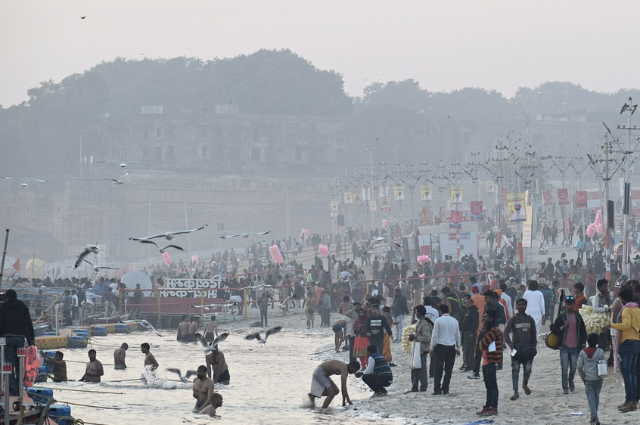
The Maha Kumbh Mela, held every twelve years at the confluence of the Ganges, Yamuna, and the mythical Saraswati rivers in Prayagraj, is a grand spiritual event. Millions of devotees from across the world gather to take a holy dip, seeking spiritual purification. However, recent water quality assessments have raised serious concerns over the safety of the Sangam waters due to alarmingly high levels of fecal coliform bacteria. This poses significant health risks, necessitating immediate attention from authorities and devotees alike.
Understanding Fecal Coliform Contamination
Fecal coliform bacteria, a subset of total coliform bacteria, originate from the intestines of warm-blooded animals, including humans. Their presence in water signifies contamination by fecal matter, raising the likelihood of pathogenic microorganisms such as E. coli, Salmonella, Vibrio cholerae, and various viruses and parasites. These pathogens can cause severe waterborne diseases, including gastrointestinal infections, dysentery, hepatitis, and cholera.
Water quality standards set by the Central Pollution Control Board (CPCB) of India stipulate that total coliform levels should not exceed 500 Most Probable Number (MPN) per 100 milliliters for safe bathing. However, recent studies indicate that coliform levels in the Sangam waters are exceeding permissible limits by thousands of times, pointing toward severe contamination. The main sources of pollution include untreated sewage discharge, open defecation, industrial effluents, and the enormous human influx during the Kumbh Mela.
Scientific studies show that water contamination occurs through direct and indirect pathways. Direct contamination involves defecation and urination near the riverbanks, whereas indirect contamination results from urban wastewater and agricultural runoff entering the rivers. The lack of efficient sewage treatment facilities exacerbates the issue, leading to the accumulation of harmful bacteria. The presence of high Biological Oxygen Demand (BOD) levels further indicates the organic pollution caused by human and industrial waste.
Recent Findings on Water Quality at the Sangam
A report submitted by the CPCB to the National Green Tribunal (NGT) on February 3, 2025, revealed that the water quality at the Sangam is unsuitable for bathing. The report highlighted alarming levels of fecal coliform bacteria, with readings on January 19, 2025, showing 700,000 MPN/100ml in the Ganges and 330,000 MPN/100ml in the Yamuna. These figures exceed the permissible limits by 1,400 times and 660 times, respectively.
Additionally, the BOD levels in the Sangam waters have consistently remained above the safe threshold. The CPCB report noted BOD levels of 5.09 mg/L on February 16, 4.6 mg/L on February 18, and 5.29 mg/L on February 19, 2025. For water to be considered safe for bathing, BOD levels should not exceed 3 mg/L. These findings indicate that organic pollution from human and industrial sources is significantly degrading water quality, making it hazardous for devotees.
Historical data from previous Maha Kumbh Melas also show similar contamination trends, but the situation has worsened due to increased urbanization and inadequate wastewater management. Compared to earlier Kumbh Melas, the current levels of pollution suggest a greater challenge in maintaining water purity despite government interventions.
Health Implications for Devotees
The presence of high fecal coliform levels poses substantial health risks to millions of pilgrims. Direct exposure to contaminated water can lead to various illnesses such as diarrhea, cholera, typhoid, and skin infections. Gastrointestinal infections caused by ingesting contaminated water can result in severe dehydration, particularly among children and the elderly, making medical intervention crucial.
Studies show that waterborne disease outbreaks have occurred in past Kumbh Melas, with thousands of cases reported annually. The absence of proper hygiene facilities, inadequate waste disposal, and overcrowding increase the likelihood of infections spreading rapidly. While medical camps are set up during the Mela, they may not be sufficient to handle large-scale outbreaks if contamination persists.
Medical experts warn that untreated sewage entering the rivers increases the risk of antibiotic-resistant bacterial strains, posing an even greater health threat. Regular water quality monitoring and public awareness campaigns are necessary to prevent large-scale health crises.
Government Response and Measures
The Uttar Pradesh government, led by Chief Minister Yogi Adityanath, has attempted to address the issue. In a statement to the state assembly, he assured that efforts had been made to treat sewage before it enters the rivers. He cited data indicating that 261 million liters of sewage are treated daily, reducing pollution levels. However, the CPCB's findings suggest that these efforts are insufficient, as contamination levels remain high.
The National Green Tribunal (NGT) has intervened by summoning government officials to explain their failure to maintain water quality. The tribunal has urged authorities to implement stricter measures, including enhanced sewage treatment, monitoring of industrial effluents, and improved sanitation infrastructure.
The government has also launched the Namami Gange initiative, aimed at cleaning the Ganges. However, experts argue that long-term solutions require stricter regulations and better enforcement of pollution control laws. Coordination between various agencies, including municipal corporations and environmental bodies, is essential to tackle this crisis effectively.
Challenges and the Way Forward
Despite government efforts, significant challenges remain in ensuring clean water at the Maha Kumbh Mela. The sheer number of pilgrims, inadequate sanitation facilities, and lack of stringent pollution controls contribute to the crisis. Temporary toilets and waste disposal mechanisms often fail to meet demand, leading to open defecation and waste accumulation near riverbanks.
One possible solution is to expand sewage treatment capacity and enforce strict monitoring of effluent discharge. Adopting advanced wastewater treatment technologies, such as bio-remediation and constructed wetlands, could help improve water quality. Public awareness campaigns can educate devotees about hygiene practices, minimizing direct contamination of river waters.
collaboration between government agencies, non-governmental organizations (NGOs), and environmental activists is crucial to achieving long-term water conservation goals. Stricter penalties for industries and municipalities that pollute the rivers must be enforced to deter violations.
Conclusion
hile the Maha Kumbh Mela remains a spiritually significant event, the alarming levels of fecal bacteria in the Sangam waters highlight a pressing public health concern. Addressing this issue requires immediate and sustained action to ensure the well-being of devotees and the preservation of these sacred rivers for future generations.
